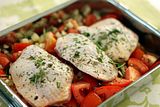
I think these look really pretty for a party I am planning. I have to confess that I just renamed them. The original recipe is for Sables, from Dorie Greenspan's "Baking From My Home to Yours." The original used sanding sugar for the decoration; I used multi-color non-pareils.
Dorie's Tips and Recipe for Sables :
Dorie's Tips and Recipe for Sables :
Don't beat the butter (or the butter, sugar and eggs) so enthusiastically that the mixture is light and fluffy. You don't want to beat air into this dough, because it would cause the cookies to puff as they bake in the oven and sink as they cool on the counter.
Be soft and gentle when you blend in the flour. This is the make-or-break step in the process. With the word "sandy" singing in your head, add the flour all at once and mix it only until it disappears into the dough. To guard against overmixing, you can mix in the last of the flour by hand.
Be soft and gentle when you blend in the flour. This is the make-or-break step in the process. With the word "sandy" singing in your head, add the flour all at once and mix it only until it disappears into the dough. To guard against overmixing, you can mix in the last of the flour by hand.
RECIPE FOR SABLES
2 sticks (8 ounces) unsalted butter, at room temperature
1/2 cup sugar
1/4 cup confectioners' sugar, sifted
1/2 teaspoon salt, preferably fine sea salt
2 large egg yolks, at room temperature, plus 1 large egg yolk, for brushing the logs
2 cups all-purpose flour
Decorating (coarse) sugar
Makes about 50 cookies
Working with a stand mixer, preferably fitted with a paddle attachment, or with a hand mixer in a large bowl, beat the butter at medium speed until smooth and very creamy. Add the sugars and salt and beat until well blended, about 1 minute. The mixture should be smooth and velvety, not fluffy and airy. Reduce the mixer speed to low and beat in 2 of the egg yolks, again beating until the mixture is homogenous.
Turn off the mixer. Pour in the flour, drape a kitchen towel over the stand mixer to protect yourself and the counter from flying flour and pulse the mixer at low speed about 5 times, a second or two each time. Take a peek — if there is still a lot of flour on the surface of the dough, pulse a couple more times; if not, remove the towel. Continuing at low speed, mix for about 30 seconds more, just until the flour disappears into the dough and the dough looks uniformly moist. (If most of the flour is incorporated but you've still got some in the bottom of the bowl, use a rubber spatula to work the rest of the flour into the dough.) The dough will not clean the sides of the bowl, nor will it come together in a ball — and it shouldn't. You want to work the dough as little as possible. What you're aiming for is a soft, moist, clumpy (rather than smooth) dough. Pinch it, and it will feel a little like Play-Doh.
Scrape the dough out onto a smooth work surface, gather it into a ball and divide it in half. Shape each piece into a smooth log about 9 inches long: it's easiest to work on a piece of plastic wrap and use the plastic to help form the log. Wrap the logs well and refrigerate them for at least 3 hours, preferably longer. (The dough can be kept in the refrigerator for up to 3 days or frozen for up to 2 months.)
1/2 cup sugar
1/4 cup confectioners' sugar, sifted
1/2 teaspoon salt, preferably fine sea salt
2 large egg yolks, at room temperature, plus 1 large egg yolk, for brushing the logs
2 cups all-purpose flour
Decorating (coarse) sugar
Makes about 50 cookies
Working with a stand mixer, preferably fitted with a paddle attachment, or with a hand mixer in a large bowl, beat the butter at medium speed until smooth and very creamy. Add the sugars and salt and beat until well blended, about 1 minute. The mixture should be smooth and velvety, not fluffy and airy. Reduce the mixer speed to low and beat in 2 of the egg yolks, again beating until the mixture is homogenous.
Turn off the mixer. Pour in the flour, drape a kitchen towel over the stand mixer to protect yourself and the counter from flying flour and pulse the mixer at low speed about 5 times, a second or two each time. Take a peek — if there is still a lot of flour on the surface of the dough, pulse a couple more times; if not, remove the towel. Continuing at low speed, mix for about 30 seconds more, just until the flour disappears into the dough and the dough looks uniformly moist. (If most of the flour is incorporated but you've still got some in the bottom of the bowl, use a rubber spatula to work the rest of the flour into the dough.) The dough will not clean the sides of the bowl, nor will it come together in a ball — and it shouldn't. You want to work the dough as little as possible. What you're aiming for is a soft, moist, clumpy (rather than smooth) dough. Pinch it, and it will feel a little like Play-Doh.
Scrape the dough out onto a smooth work surface, gather it into a ball and divide it in half. Shape each piece into a smooth log about 9 inches long: it's easiest to work on a piece of plastic wrap and use the plastic to help form the log. Wrap the logs well and refrigerate them for at least 3 hours, preferably longer. (The dough can be kept in the refrigerator for up to 3 days or frozen for up to 2 months.)
GETTING READY TO BAKE: Center a rack in the oven and preheat the oven to 350 degrees F. Line two baking sheets with parchment or silicone mats.
Remove a log of dough from the refrigerator, unwrap it and place it on a piece of parchment or wax paper. Whisk the remaining egg yolk until it is smooth, and brush some of the yolk all over the sides of the dough — this is the glue — then sprinkle the entire surface of the log with decorating sugar.
Trim the ends of the roll if they're ragged, and slice the log into 1/3-inch-thick cookies. (You can make these as thick as 1/2 inch or as thin as — but no thinner than — 1/4 inch.) Place the rounds on the baking sheets, leaving an inch of space between them.
Bake one sheet at a time for 17 to 20 minutes, rotating the baking sheet at the midway point. When properly baked, the cookies will be light brown on the bottom, lightly golden around the edges and pale on top; they may feel tender when you touch the top gently, and that's fine. Remove from the oven and let the cookies rest a minute or two before carefully lifting them onto a rack with a wide metal spatula to cool to room temperature.
Repeat with the remaining log of dough, making sure the baking sheets are cool before you bake the second batch.
My Bench Notes: (1) Use fine, light decorations - sanding sugar, non-pareils, etc. I started with coarse sanding sugar and some of the edges fell off the sables as they were too heavy!
(2) Chill each full tray for about 10 minutes once the rounds are on the trays. Then bake.
(3) I really, really must confess I prefer regular, ordinary parchment paper to silpats for these cookies.
They are lovely buttery cookies and well worth a bit of fussing with the shaping.
























